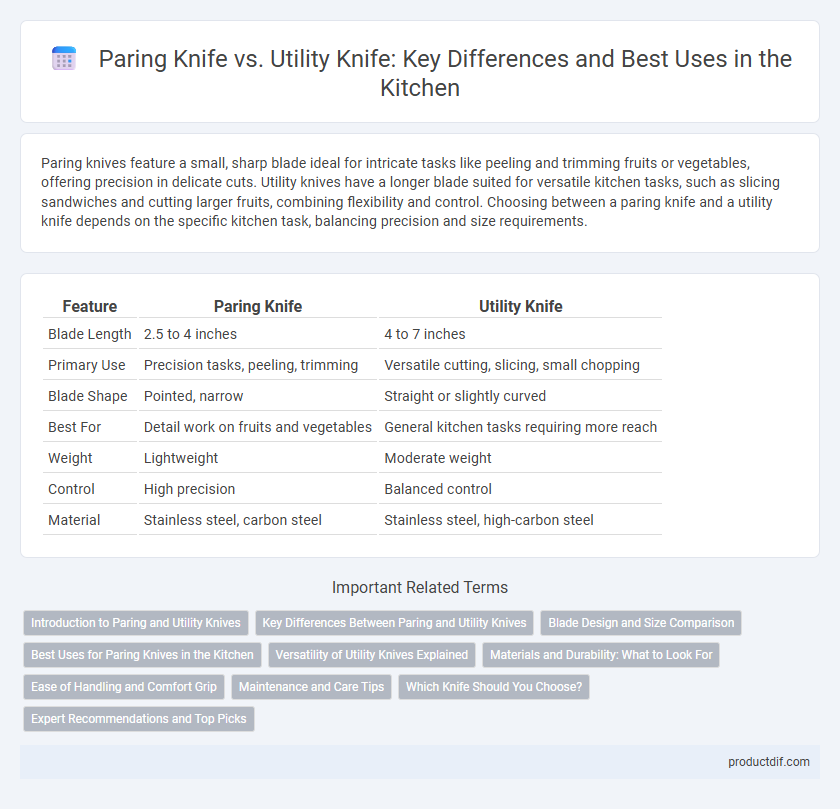Paring knives feature a small, sharp blade ideal for intricate tasks like peeling and trimming fruits or vegetables, offering precision in delicate cuts. Utility knives have a longer blade suited for versatile kitchen tasks, such as slicing sandwiches and cutting larger fruits, combining flexibility and control. Choosing between a paring knife and a utility knife depends on the specific kitchen task, balancing precision and size requirements.
Table of Comparison
| Feature | Paring Knife | Utility Knife |
|---|---|---|
| Blade Length | 2.5 to 4 inches | 4 to 7 inches |
| Primary Use | Precision tasks, peeling, trimming | Versatile cutting, slicing, small chopping |
| Blade Shape | Pointed, narrow | Straight or slightly curved |
| Best For | Detail work on fruits and vegetables | General kitchen tasks requiring more reach |
| Weight | Lightweight | Moderate weight |
| Control | High precision | Balanced control |
| Material | Stainless steel, carbon steel | Stainless steel, high-carbon steel |
Introduction to Paring and Utility Knives
Paring knives typically feature a small, sharp blade ranging from 2.5 to 4 inches, designed for precision tasks like peeling, trimming, and intricate cutting in kitchenware. Utility knives have a slightly longer blade, usually around 4 to 7 inches, offering versatility for slicing fruits, vegetables, and small cuts of meat. Both knives are essential in culinary preparation, with paring knives excelling at detail work and utility knives handling a broader range of kitchen cutting needs.
Key Differences Between Paring and Utility Knives
Paring knives feature a small, sharp blade typically 2.5 to 4 inches long, ideal for precision tasks like peeling and trimming fruits and vegetables. Utility knives, with longer blades ranging from 4 to 7 inches, offer versatility for slicing sandwiches, cutting meat, and other mid-sized kitchen tasks. Paring knives prioritize control and detail, whereas utility knives balance agility and strength for more general cutting purposes.
Blade Design and Size Comparison
Paring knives typically feature a small, narrow blade ranging from 2.5 to 4 inches, designed for precise tasks like peeling and intricate cutting. Utility knives have a larger blade, usually 4 to 7 inches long, with a broader profile suited for versatile cutting, slicing, and trimming. The blade design of paring knives emphasizes control and delicacy, while utility knives balance sharpness with strength for multipurpose kitchen use.
Best Uses for Paring Knives in the Kitchen
Paring knives excel at precision tasks such as peeling fruits and vegetables, deveining shrimp, and intricate garnishing. Their small, sharp blade allows for controlled cuts and detailed work, making them ideal for tasks that require accuracy. They are less suited for heavy-duty chopping or slicing larger items where a utility knife is preferred.
Versatility of Utility Knives Explained
Utility knives offer exceptional versatility in the kitchen, bridging the gap between paring knives and chef's knives with a medium-sized blade typically 4 to 7 inches long. Their slender, sharp edges excel at slicing fruits, vegetables, and small cuts of meat, making them ideal for tasks that require more precision than a chef's knife but more power than a paring knife. Unlike paring knives, which are mainly designed for peeling and intricate work, utility knives adapt comfortably to a wide range of chopping, cutting, and trimming activities.
Materials and Durability: What to Look For
Paring knives typically feature high-carbon stainless steel blades for precision and corrosion resistance, while utility knives often use stainless steel or VG-10 steel to balance sharpness and durability. Look for full tang construction and ergonomic handles made from durable materials such as pakkawood or polypropylene to ensure long-lasting comfort and control. High-quality blade coatings like titanium or ceramic can further enhance scratch resistance and prolong the lifespan of both paring and utility knives.
Ease of Handling and Comfort Grip
Paring knives offer exceptional ease of handling due to their small, lightweight design, making precise tasks like peeling and trimming comfortable even during extended use. Utility knives, slightly larger with a balanced weight distribution, provide a secure, ergonomic grip suitable for versatile cutting jobs without causing hand fatigue. Both knives feature textured, non-slip handles crafted from materials such as rubber or polymer, enhancing comfort and control in busy kitchen environments.
Maintenance and Care Tips
Regular sharpening of paring knives and utility knives with a whetstone or honing rod preserves edge precision essential for intricate and general kitchen tasks. Hand washing these knives immediately after use with mild detergent prevents corrosion and maintains blade integrity, avoiding damage from dishwasher detergents and high heat. Proper storage in a knife block or magnetic strip prevents blade dullness and accidents, extending the lifespan of both paring and utility knives.
Which Knife Should You Choose?
Choose a paring knife for precision tasks like peeling, trimming, and detailed cutting thanks to its small, sharp blade ranging from 2.5 to 4 inches. Opt for a utility knife with a longer blade, typically 4 to 7 inches, to handle medium-sized slicing and chopping jobs that are too large for a paring knife but too delicate for a chef's knife. Selecting the right knife depends on the specific kitchen task, with paring knives excelling in fine work and utility knives offering versatile, all-purpose cutting capabilities.
Expert Recommendations and Top Picks
Expert chefs recommend paring knives for precision tasks such as peeling and intricate cutting, praising brands like Wusthof and Global for their sharpness and durability. Utility knives, favored for versatility in slicing fruits, vegetables, and meats, often rank high with models from Victorinox and Shun, which offer excellent balance and edge retention. Top picks consistently highlight the paring knife's maneuverability and the utility knife's adaptability as essential tools in a professional kitchen setup.
Paring Knife vs Utility Knife Infographic

 productdif.com
productdif.com